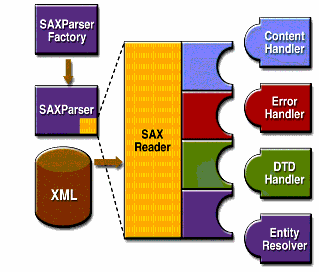Lesson: Introduction to JAXP
Java 教程是为 JDK 8 编写的。本页中描述的示例和实践未利用在后续版本中引入的改进。
XML API 的简单 API
The basic outline of the SAX parsing APIs is shown in Figure 1-1. To start the process, an instance of the SAXParserFactory class is used to generate an instance of the parser.

The parser wraps a SAXReader object. When the parser's parse() method is invoked, the reader invokes one of several callback methods implemented in the application. Those methods are defined by the interfaces ContentHandler, ErrorHandler, DTDHandler, and EntityResolver.
Here is a summary of the key SAX APIs:
- SAXParserFactory
-
A SAXParserFactory object creates an instance of the parser determined by the system property, javax.xml.parsers.SAXParserFactory.
- SAXParser
-
The SAXParser interface defines several kinds of parse() methods. In general, you pass an XML data source and a DefaultHandler object to the parser, which processes the XML and invokes the appropriate methods in the handler object.
- SAXReader
-
The SAXParser wraps a SAXReader. Typically, you do not care about that, but every once in a while you need to get hold of it using SAXParser's getXMLReader() so that you can configure it. It is the SAXReader that carries on the conversation with the SAX event handlers you define.
- DefaultHandler
-
Not shown in the diagram, a DefaultHandler implements the ContentHandler, ErrorHandler, DTDHandler, and EntityResolver interfaces (with null methods), so you can override only the ones you are interested in.
- ContentHandler
-
Methods such as startDocument, endDocument, startElement, and endElement are invoked when an XML tag is recognized. This interface also defines the methods characters() and processingInstruction(), which are invoked when the parser encounters the text in an XML element or an inline processing instruction, respectively.
- ErrorHandler
-
Methods error(), fatalError(), and warning() are invoked in response to various parsing errors. The default error handler throws an exception for fatal errors and ignores other errors (including validation errors). This is one reason you need to know something about the SAX parser, even if you are using the DOM. Sometimes, the application may be able to recover from a validation error. Other times, it may need to generate an exception. To ensure the correct handling, you will need to supply your own error handler to the parser.
- DTDHandler
-
Defines methods you will generally never be called upon to use. Used when processing a DTD to recognize and act on declarations for an unparsed entity.
- EntityResolver
-
The resolveEntity method is invoked when the parser must identify data identified by a URI. In most cases, a URI is simply a URL, which specifies the location of a document, but in some cases the document may be identified by a URN - a public identifier, or name, that is unique in the web space. The public identifier may be specified in addition to the URL. The EntityResolver can then use the public identifier instead of the URL to find the document-for example, to access a local copy of the document if one exists.
A typical application implements most of the ContentHandler methods, at a minimum. Because the default implementations of the interfaces ignore all inputs except for fatal errors, a robust implementation may also want to implement the ErrorHandler methods.
SAX Packages
The SAX parser is defined in the packages listed in the following Table .
|
包 |
描述 |
|---|---|
|
org.xml.sax |
Defines the SAX interfaces. The name org.xml is the package prefix that was settled on by the group that defined the SAX API. |
|
org.xml.sax.ext |
Defines SAX extensions that are used for doing more sophisticated SAX processing-for example, to process a document type definition (DTD) or to see the detailed syntax for a file. |
|
org.xml.sax.helpers |
Contains helper classes that make it easier to use SAX-for example, by defining a default handler that has null methods for all the interfaces, so that you only need to override the ones you actually want to implement. |
|
javax.xml.parsers |
Defines the SAXParserFactory class, which returns the SAXParser. Also defines exception classes for reporting errors. |